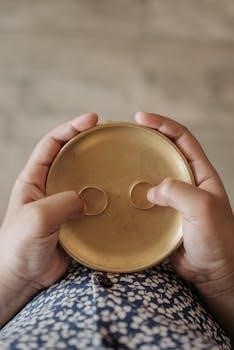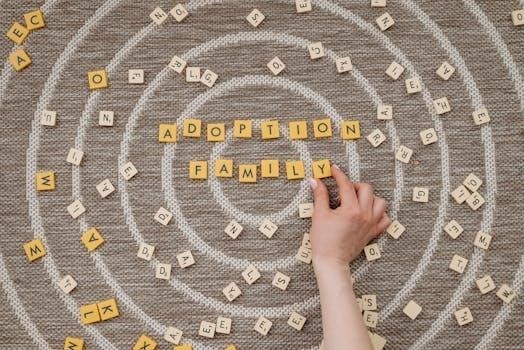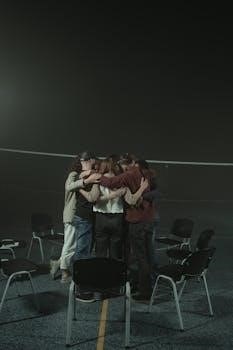
relationship circles pdf
Relationship Circles⁚ A Comprehensive Guide
Relationship Circles offer a visual method to explore and strengthen connections. They aid understanding of support networks, improve personal development, and foster self-awareness. PDF templates assist in mapping these vital relationships.
Understanding Relationship Circles
Relationship circles are visual tools that map out your social connections, offering insights into the quality and structure of your relationships. Analyzing these circles aids in identifying support systems and potential areas for growth. PDF templates often provide a structured framework for this process. Utilizing such diagrams enhances self-awareness and assists in strengthening meaningful relationships. Explore the dynamics of your social network today!
What are Relationship Circles?
Relationship Circles are visual diagrams mapping personal connections. Often using PDF templates, they illustrate the varying degrees of intimacy and support within one’s network. These circles aid self-reflection on relationships.
Definition and Purpose
Relationship Circles, often facilitated by PDF worksheets, are visual tools used to map and analyze an individual’s network of relationships. The definition lies in its concentric design, illustrating varying degrees of connection and support. The purpose extends beyond simple mapping; it aims to foster self-awareness, identify strengths and gaps in one’s support system, and ultimately, improve the quality and intentionality of relationships for enhanced well-being.
Benefits of Mapping Relationship Circles
Mapping Relationship Circles, often using PDF templates, offers several key benefits. Firstly, it enhances self-awareness by visualizing your social ecosystem. Secondly, it identifies potential gaps in your support system, highlighting areas where stronger connections are needed. Thirdly, it facilitates boundary setting, allowing you to understand and manage the energy flow within different relationships. Finally, it can improve overall well-being by fostering stronger, more intentional connections with others, leading to a more fulfilling life.

Key Components of a Relationship Circle
Relationship Circles consist of concentric layers. The innermost circle represents intimate connections. Subsequent circles include close friends, family, and acquaintances. Analyzing these components, often using a PDF, illuminates social dynamics.
The Inner Circle⁚ Intimate Relationships
The inner circle signifies your closest bonds. These are the individuals you cannot live without. Intimate relationships, like immediate family or a significant other, reside here. They offer unwavering support and understanding; A relationship circle PDF can help visualize who comprises this vital group. It is your primary family. They are the people closest to you, with whom you spend the most time. They offer emotional support.
The Second Circle⁚ Close Friends and Family
This circle contains close friends and extended family. These are individuals you trust and enjoy spending time with. They provide emotional support and companionship. While not as intimate as the inner circle, they play a significant role in your life. Using a relationship circle PDF, identify those who offer consistent support and positive interactions. Consider those friends and family you are wired to connect with.
Outer Circles⁚ Acquaintances and Community
These circles encompass acquaintances, colleagues, and members of your community. These connections may be less frequent but still contribute to your overall well-being. Consider neighbors, classmates, and individuals you interact with regularly. While not providing deep emotional support, they offer opportunities for social interaction and a sense of belonging. Using a relationship circle PDF can help you visualize and appreciate these broader connections within your community, and where you may need more connection.
Creating Your Own Relationship Circle
Crafting your relationship circle involves visualizing connections and support systems. Utilizing PDF templates simplifies the process. It allows reflection on social networks, promoting a balanced and fulfilling life through mapped relationships.
Tools and Templates (PDF Examples)
Several tools and templates can aid in visualizing your relationship circles. PDF examples offer structured layouts for mapping connections. These templates often include concentric circles for categorizing intimacy levels. They simplify documenting friends, family, and acquaintances. Customizable PDFs allow tailoring circles to specific needs and goals. These visual aids enhance self-awareness, improving social connections and support systems effectively. Consider exploring various PDF options to find the best fit.
Steps to Draw and Analyze Your Circle
Begin by listing all significant relationships. Draw concentric circles representing levels of intimacy. Place names within appropriate circles. Consider using a PDF template for guidance. Analyze the distribution of relationships. Identify gaps or imbalances in your support system. Reflect on the quality of each connection. Are your needs being met? Note any areas needing improvement. Regularly revisit and update your relationship circle. This process fosters self-awareness and strengthens social connections, enhancing overall well-being.

Applications of Relationship Circles
Relationship Circles enhance self-awareness and improve support systems. They aid personal development and strengthen social connections. PDF resources assist in mapping and analyzing relationships, especially within the disability community, for effective support planning.
Personal Development and Self-Awareness
Relationship Circles offer invaluable insights into your connections, promoting profound self-awareness. By visualizing your support network through a PDF template, you gain clarity on who influences your life and emotional well-being. This understanding fosters personal growth by identifying areas where you may need stronger connections or healthier boundaries. Reflecting on these circles helps you understand relationship dynamics.
Improving Social Connections and Support Systems
Relationship Circles, often facilitated by PDF resources, are instrumental in enhancing social connections. Mapping your current network reveals gaps in your support system. This awareness allows for targeted efforts to cultivate new relationships or strengthen existing ones. By visualizing your connections, you can identify underutilized resources and actively build a more robust and balanced support system. These targeted efforts improve quality of life.
Use in Disability Community and Support Planning
Relationship Circles are especially valuable within the disability community. Often utilizing PDF templates, these circles aid in support planning. They help individuals visualize their existing network of support. This visualization identifies potential gaps and helps to build a more comprehensive and inclusive support system. These circles empower individuals with disabilities, their families, and support teams to collaboratively create personalized support plans. Relationship circles improve quality of life.
Relationship Circles and Boundaries
Relationship Circles help visualize and understand personal boundaries. By mapping connections using templates like a PDF, individuals can assess relationship priorities. This promotes healthier boundaries within their support networks.
Setting and Maintaining Healthy Boundaries
Establishing clear boundaries is crucial for healthy relationships. Relationship circles, potentially visualized using a PDF, offer a framework to define these limits. By understanding the different levels of intimacy and support within each circle, individuals can communicate their needs effectively. Prioritizing self-care and respecting personal space becomes easier when boundaries are clearly defined and consistently maintained, fostering more fulfilling connections with others and within your social network.
Understanding Priorities in Relationships
Relationship Circles, often created using a PDF template, help visualize and prioritize connections. Recognizing who falls into the inner circle versus outer circles clarifies where to invest time and energy. Evaluating these diagrams aids in understanding which relationships are most vital for support, intimacy, and overall well-being. This awareness fosters intentionality in nurturing key bonds while managing expectations within less critical connections. Recognizing that relationships impact the quality of life.
Relationship Circles in Different Contexts
Relationship Circles, often documented using a PDF, find application in restorative practices and community support. These circles foster connection and aid in understanding social dynamics within varied settings.
Restorative Practices and Connection Circles
Within restorative practices, connection circles, potentially documented via PDF, emphasize relationship, respect, and responsibility. These circles facilitate repair and reintegration, fostering a sense of belonging. Connection circles visualize relationships in a system. Modified intervention worksheets aid analysis. They ensure healthy boundaries and promote positive interactions, supporting emotional well-being and community cohesion. These practices adhere to principles and values.
Circles of Support in Communities
Circles of support, potentially visualized using PDF templates, have existed across societies, emphasizing belonging and connection. They facilitate community care, adapting to various populations. These circles promote inclusivity, especially within the disability community. Relationship circles map connections, fostering self-awareness. PDF versions are easily shareable. They highlight the importance of understanding personal boundaries. Strong community support enhances quality of life, reflecting the power of positive relationships.

Adapting Relationship Circle Worksheets
Relationship Circle worksheets, often available as PDFs, are adaptable for diverse needs. Modifying questions and prompts tailors them for specific purposes and populations, promoting personalized relationship exploration and analysis.
Modifying for Various Purposes and Populations
Relationship Circle worksheets, especially those in PDF format, offer flexibility. They can be tailored to suit diverse populations and specific goals. Modifications might involve adjusting question prompts, altering the number of circles, or focusing on particular relationship types. This adaptability ensures the tool remains relevant and effective across varied contexts, including personal development, community support, and restorative practices, maximizing its utility for individual and group use.
Examples of Tailored Worksheets
Consider a PDF worksheet designed for youth, simplifying the circle divisions and using age-appropriate language. For individuals with disabilities, worksheets might incorporate visual aids and focus on support networks. A grief-focused worksheet could center on past relationships and coping mechanisms. Worksheets designed for professional settings might emphasize workplace connections and mentorship opportunities. These examples demonstrate how Relationship Circle PDFs adapt, ensuring relevance and accessibility for diverse populations and specific therapeutic or developmental goals, enhancing their practical application.

Visualizing Relationships with Circle Diagrams
Circle diagrams, including Venn diagrams, offer visual representations of relationships. These diagrams enhance understanding of connections, which is supported by PDF templates. They are useful for storytelling and systems analysis about relationships.
Using Venn Diagrams to Represent Relationships
Venn diagrams, employing overlapping circles, visually depict the connections and commonalities between individuals or groups. They provide clarity on shared aspects within relationships, aiding in understanding complex social dynamics. These diagrams, sometimes available as PDF resources, are useful for exploring interactions and overlapping interests. They help illustrate where relationships converge and diverge and can provide clarity to the user.
Connection Circles for Storytelling and Systems Analysis
Connection circles serve as valuable tools for visualising relationships within narratives or complex systems. They aid in analysing how different elements interact and influence each other. Utilizing circle diagrams can reveal hidden patterns and dependencies. These visual aids, potentially found in PDF guides, are effective for understanding character dynamics in stories or identifying key leverage points within larger systems. It also helps reveal dependencies in the circle.
The Importance of Relationships
Relationships significantly impact quality of life. Mapping them using relationship circles, perhaps with a PDF guide, highlights their importance. Strong connections correlate with well-being, underscoring their crucial role.
Impact on Quality of Life
Research indicates relationships are a top variable influencing life quality, outweighing factors like money or fame. Strong connections foster well-being and community involvement. Visualizing these bonds through relationship circles, aided by PDF templates, can enhance understanding. Exploring and nurturing these connections is paramount for a fulfilling life, offering emotional support and a sense of belonging, ultimately improving overall happiness.
Common Mistakes and How to Avoid Them
Dunbar’s Number and Social Network Limitations
Dunbar’s number highlights cognitive limits on manageable relationships. This concept explains why our social networks have natural boundaries. Relationship circles, possibly using a PDF guide, visually represent these limitations, aiding in understanding where to focus social energy. Recognizing these constraints allows for prioritizing meaningful connections, optimizing social interactions, and fostering deeper, more supportive relationships within the defined circle. This promotes more effective social resource management.